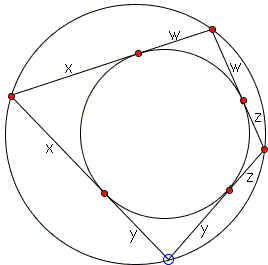GUIDANCE TUITION CENTRE.ALAKODE FOR HIGHSCHOOL STUDENTS ഹായ് കൂട്ടുകാരെ , പ്രധാനമായും ഹൈസ്കൂള് കുട്ടികള്ക്കുവേണ്ടിയാണ് ഈ ബ്ലോഗ് ഒരുക്കിയിയിരിക്കുന്നത് . കണക്കിന്റെയും ഇoഗ്ലീഷിന്റെയും ചോദ്യങ്ങള് ഈ ബ്ലോഗില് നിന്നും നിങ്ങള്ക്ക് ലഭിക്കും .കേരള സിലബസ് ആണ് കൂടുതലായി ഉണ്ടാവുക .എന്നാല് CBSE syllabus കൂടി ഉള്പെടുതുന്നുണ്ട്.നിങ്ങളുടെ അഭിപ്രായങ്ങള് കമന്റ് ആയി പോസ്റ്റ് ചെയ്യാവുന്നതാണ് നന്ദി .............
Sunday, July 8, 2012
Friday, July 6, 2012
Area of a Bicentric Quadrilateral
Area of a Bicentric Quadrilateral
A quadrilateral ABCD is bicentric if it is both inscriptible, i.e. admits an inscribed circle, and circumscriptible, i.e., cyclic - admits a circumscribed circle. The formula for the area of a cyclic quadrilateral has been discovered by the 7th century Indian mathematician Brahmagupta. In terms of the side lengths a, b, c, d and the semiperimeter
S = √(s - a)(s - b)(s - c)(s - d),
or more explicitly,
4S = √(- a + b + c + d)(a - b + c + d)(a + b - c +
d)(a + b + c - d).
For a bicentric quadrilateral, the formula allows for a significant
simplification:proof:
For a bicentric quadrilateral with side lengths a, b, c, d, the area S is
given by
S = √abcd,
Proof

In a bicentric quadrilateral, the sides are each a sum of two adjacent tangents from the vertices to the inscribed circle. Denoting those tangents x, y, z, w, we can write, say,
a = x + y,
b = y + z,
c = z + w,
d = w + x.
b = y + z,
c = z + w,
d = w + x.
The factors involved in the Brahmagupta's formula can be expressed differently:
- a + b + c + d = 2(w + z) = 2c,
a - b + c + d = 2(x + w) = 2d,
a + b - c + d = 2(y + x) = 2a,
a + b + c - d = 2(z + y) = 2b.
a - b + c + d = 2(x + w) = 2d,
a + b - c + d = 2(y + x) = 2a,
a + b + c - d = 2(z + y) = 2b.
A substitution into Brahmagupta's formula gives
4S = √16abcd,
which is the required formula.
Subscribe to:
Posts (Atom)